is revered as a Shakti shrine,
situated 10 km west of Palampur located in the state of Himachal
Pradesh. This is the place where the Demons
and during the fight, the Devi
cut their heads. The heads were then presented to
. This Sidhapeeth has now become a place where saints and
priests pray amidst natural surroundings. Since this colorful shrine
has a wrathful form of Chamunda or Mahakali, it is considered to be
very sacred. The idol in the temple is completely hidden beneath a red
cloth and it is believed that here Lord Shiva is present in the form
of death, destruction and dead bodies along with Chamunda Devi.
Devotees flock to this temple to offer prayers, worship and give
offerings for their ancestors.
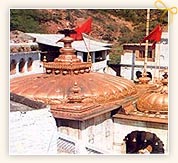
Jwalaji in the Kangra district of Himachal Pradesh
is well-known for the famous
Jwalaji Temple which is one of
the fifty-one Shakti Peeths in the country. It is said that when,
Sati, the consort of Lord Shiva, killed herself by jumping in the
sacrificial fire when her father Daksha Prajapati insulted her
husband, an enraged Shiva started roaming the entire universe with
the body of Sati in his arms. His movement created havoc and
imbalance in the Universe. To calm down the anger of Shiva, Lord
Vishnu dismembered the dead body of Sati and various parts of the
body fell at 51 different places in India which later on became
sacred as
Shakti Peeths. It is believed that Sati's tongue
had fallen at the very place where Jwalaji Temple is now situated.
The tongue of Sati is represented by
Jwala (Holy Flame) that
is perpetually burning. The flames come out from nine different
rocks in the temple. It is said that the Pandavas have visited this
sacred place. Even Emperor Akbar paid yearly visit to this Temple
after he became impressed with the holy flames that kept burning
even after he had put a massive
chhatra (canopy) over it to
extinguish the flame. The climat of this region is quite moderate
with cool but pleasant winters and warm summers.
Kedarnath

Kedarnath is a Hindu holy town located in the the
Indian state of Uttaranchal. The place is located at an altitude
of 3,584 m and at the origin of the river Mandakini, the temple of
Kedarnath is the most venerated place for Hindu pilgrims. Amidst
the dramatic mountain scapes of the majestic Kedarnath range
stands one of the twelve 'Jyotirlingas' of Kedar or Lord Shiva.
Kedarnath hosts one of the holiest Hindu temples and is a popular
destination for Hindu pilgrims from all over the world. The place
is accessible after a steep 13 km trek over a paved path from
Gaurikund. Rishikesh, Haridwar, Dehradun are well connected to
Gaurikund by road. There are different places on the route like-
Rambara, Janglechatti and Garurchatti, where one can spend some
time while trekking or can even spend a night as a halting
station. There is a high and beautiful cascading waterfall just
one kilometer before Rambara. The main attraction at Kedarnath is
the Kedarnath Jyotirlinga Temple, which is one of the Panch
Kendras located in the Himalayas, at the source of the Mandakani
river. It is about 120000 feet above the sea level. One can get a
glimpse of the God when traveling by foot. The picture perfect
setting with breathtaking scenic beauty transforms it in a heaven.
Perpetually covered with snow, the place is best accessible from
May to October except the Monsoon.
The credit for the construction of this heavenly temple is given
to the Pandavas. The entrance starts with the statue of Nandi, the
divine bull of Shiva. Fine & detailed carvings exhibiting images
can be seen on the walls inside. The shiva lingam is in the form
of a pyramid. The Kedar dome peak is located exactly behind the
temple. It can be viewed from great distance as well. The temple
is located on the Rudra Himalaya range, also known as the Pancha
Parvata. It is believed that four of the Pandavas died on one of
the peaks, Swargarohini.
The holy statue of Shiva is carried from Garhwal (Kedarkhand) to
Ukhnimath in November which is then restablished at Kedarnath in
the first week of May. The doors of the temple are now thrown open
to pilgrims.
Mythology states that the deity of Kedarnath temple is identified
with the rump of a bull. Shiva had camouflaged himself while
eluding the Pandavas, who had come to repent for killing their
kith and kin, during the battle of Kurukshetra. Shiva dived into
the ground, thus, leaving a hump on the surface. This very conical
projection is worshipped till now.
The temple is open only during the months of May to October, due
to heavy snowfall and extreme cold weather during winter. The
origin of this revered temple is mentioned in the great
epic-Mahabharata. According to the saying it is believed that the
Pandavas came to Lord Shiva to seek blessings to atone their sins
after the battle of Mahabharata. Lord Shiva evaded them
continuously and took refuge in Kedarnath in the form of a Bull.
On being chased, Lord Shiva left his hump behind. This conical
protusion is worshiped in the temple. During the winters, the
shrine is submerged in snow and hence is closed. The ideal time to
visit is between May to October. The remaining portions of Lord
Shiva are worshiped at four other places like-
- The arms {baahu} - at Tungnath
- The mouth {mukh} - at Rudranath
- The hair {jata} - at Kapleshwar
Things to remember
- The best season to visit is May to October except monsoon
- One may carry light woolens in summer and must carry heavy
woolens in winter
- The colloquial Language in use are Hindi, Garhwali and
English
- The nearest airport is Jolly Grant, Dehradun (251 kms.)
- The nearest railway stations are Rishikesh (234 kms.)
Kotdwar (260 kms.)
- The walking route starts from Gaurikund which is connected
by road to Rishikesh, Kotdwar, Dehradun, Haridwar and other
important hill stations of Garhwal and Kumaon region
- There are halting stations like Dharamshalas, Ashrams,
Cottages and Tourist Rest House for comfortable stay
There are some important fairs that are organized at Kedarnath
anually like :
- Nagnath (Feb.)
- Sardotsava, Joshimath (Feb.)
- Sardotsava Chamoli, Gopeshwar (Feb. - Mar.)
- Shivaratri, Gopeshwar (Feb. - Mar.)
- Nanda Devi, Nauti (Mar.)
- Maithan, Maithan (Mar.)
- Bishwat Sankranti, Karnaprayag
- Nandprayag (April)
- Bikhot, Agastyamuni (April)
- Nautha, Adi Badri (May)
- Kaviltha, Kaviltha (Jun.)
- Naumi, Jasoli Haryali (Aug.)
- Bhaikhal, Mela, Bhaikhaltal (Aug.)
Mathura
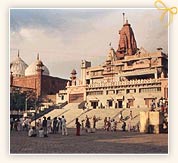
Considered to be the birth place of Lord Krishna,
Mathura, a small town on the River Yamuna in the state of
Uttar Pradesh, is an important place of pilgrimage in the country.
Krishna is supposed to be the best known, best loved and most
complex of Lord Vishnu's manifestations. It is a place of temples
and shrines bustling with the thousands of devotees who come to
visit this place of Lord Krishna. There is the splendid temple at
the
Katra Keshav Dev which marks the spot believed to be
Shri Krishna
Janmasthan by his devotees. There is another
beautiful shrine, the
Gita Mandir, on the Mathura-Vrindavan
Road which has a fine image of Shri Krishna in its sanctum. The
whole of the Bhagwad Gita is inscribed on the walls of this
temple. Another most popular shrine at Mathura is the
Dwarikadhish Temple to the north of the town.
Vishram Ghat
is the most important of all the 25 ghats in Mathura today. It is
believed that Shri Krishna took his rest here after killing
Kansa. The
aarti held at the Vishram Ghat is a
spectacular sight. It is also said that no pilgrimage to Mathura
is complete without a visit to its kunds. According to tradition,
there were 159 ancient kunds in all. Of these only four can be
seen. These are the
Shiv Tal Kund, Potara Kund , Balbhadra Kund
and Saraswati Kund. The town has also a number of Shaivite
temples.
Prayag
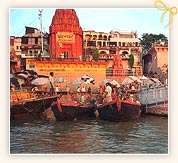
Prayag is situated at the confluence of holy
rivers Ganga and Yamuna in Allahabad, Uttar Pradesh and Indian
mythology states that the invisible Saraswati river also joins
here. Hence, it is also called
Sangam and is said to have
soul cleansing powers.
Prayag is considered to be one of
the ancient pilgrimage centers of India and is revered in the
hymns of the Rig Veda. Tradition regards this region between the
Ganga and the Yamuna as the most fertile region on earth. Sangam
draws pilgrims from all over the world round the year but
especially at the time of the
Maha Kumbh Mela. Millions of
devotees bathe ritually in the waters to break the eternal cycle
of reincarnation. The most famous temples of Prayag are the
Hanuman temple, Saraswati Ghat and
Patalpuri Temple.
Rishikesh
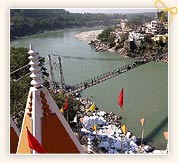
Located in the Tehri-Garhwal region of Uttar
Pradesh, Rishikesh represents the Gateway to the Himalayas. It is
small town, renowned as an important pilgrimage center of the
country. The town abounds in natural splendour and the sight of
the Ganga rushing through the Himalayan foothills is awesome.
There are several temples on the banks of the Ganga at Rishikesh.
It is believed that Rishikesh represents the site where Vishnu
vanquished the demon
Madhu. In
Tapovan, on the other
side of the Ganges, is a temple to Lakshmana. The
Lakshman
Jhula at Rishikesh is a 450 feet long suspension bridge was
built in 1939. There is a newer bridge which has been added
recently - the
Ram Jhula. Another commanding spectacular
view of the region is the
Nilkanth Mahadeo temple at a
height of about 5000 feet, 12 km away from Rishikesh. Rishikesh is
not only popular for its religious significance but also
considered to be a base for devotees on their journey to the
Char Dham Yatra (tour of four pilgrim sites). The freshness of
the air, sound of flowing water, the scenic beauty, the distant
sound of bells create an unforgettable experience for those that
visit this ancient town.
Uttarkashi
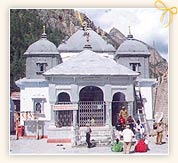
Uttarkashi is an important pilgrimage center of
the country located in the Garhwal region of the state of
Uttaranchal. Situated at a distance of 145 kms from Rishikesh and
at an elevation of 1158 meters on the banks of river
Bhagirathi,
this ancient town is the gateway to the pilgrim route to
Gangotri and
Yamunotri. Uttarkashi also holds the grace
of having the origin of rivers Ganga and Yamuna. It is also known
as the
"Devbhumi" (The land of gods and goddesses).
Uttarkashi is known for its temples dedicated to
Parshurama,
Annapurna, Devi, Datatryea, Kali Bhairon and other gods and
goddesses. The climate of Uttarkashi is cold in winters and
pleasant in summers. Not only the place an important religious
center but also with its charming valleys, natural lakes,
fountains and beauteous landscapes, ridges and mountains with
snow-capped peaks makes the district an utmost attraction for the
tourists, the pilgrims and for those having a zeal for adventures
of trekking and mountaineering.
Vaishno Devi
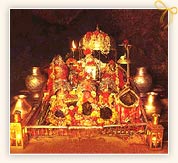 Vaishno Devi
Vaishno Devi is one of the most important
pilgrimage centers of the country. It is located in the mighty
Trikuta mountain, 61 kilometers north of Jammu at a height of
5,200 feet above the sea level in the state of Jammu and Kashmir.
According to legend, more than 700 years ago Vaishno Devi a
devotee of Lord Vishnu had taken vow of celibacy but Bhairon Nath,
a
"tantric" (demon-God) tried to behold Her and chased her
towards the Trikuta mountains. It took Bhairon nine months to
locate Her inside the cave known as
Garbh Joon. Mata
Vaishno Devi blasted an opening at the other end of the cave and
on arriving at the Holy Cave at Darbar, she assumed the form of
Maha Kali and thereby cut off Bhairon Nath's head. The head
then flung up the mountain by the force of the blow and fell at
the place where now the
Bhairon Temple is located. It is a
common belief among the devotees that Maa Vaishno sends a
"call' to her devotees and whoever receives it, wherever he or
she is, marches towards the holy shrine. It seems there is a
supernatural power which seems to draw them through the mountain
and they climb up those great heights, chanting
"Prem se bolo,
Jai Mata Di". There are images of three deities inside the
cave-
The Mahakali, Maa Saraswati and Maha Lakshmi. The
shrine of Vaishno Devi is flocked every year by thousands of
pilgrims.
Varanasi

Varanasi also known as Benares, Banaras, or
Benaras or Kashi is a renowned Hindu holy city situated on the
banks of the river Ganges in the state of Uttar Pradesh. According
to legends, the city was founded by Hindu god
Shiva, and
hence it is one of the most important pilgrimage destinations in
the country. In fact, it is considered to be one of the seven
sacred cities of Hindus where more than 1,000,000 pilgrims visit
each year. There are large number of temples in the city. The most
important one is the
Kashi Vishwanath Temple (an aspect of
Lord Shiva) which is one of the 12 revered
Jyotirlingas of
the Lord Shiva. There is also the red coloured
Durga Temple
accompanied by a rectangular tank of water called
Durga Kund.
There is the
Birla Temple built as a replica of the old
Kashi Vishwanath Temple. According to a popular belief, this city
is one of the
Shakti Peeths where Divine Mother Sati's
earring fell and therein stands the present
Vishalakshi Temple.
Some says that it is one of the four pilgrimage sites designated
by
Gautama Buddha. It is also a pilgrimage place for Jains
as it is said to be the birthplace of
Parshvanatha, the
23rd Tirthankar. Vaishnavism and Shaivism have co-existed in this
holy place harmoniously. This place is so sacred that there is a
belief that people dying in the holy city of Varanasi circumvents
rebirth and attains salvation.
Vrindavan
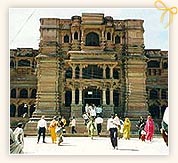
Located at a distance of 15 km from Mathura in
the state of Uttar Pradesh, Vrindavan is another major place of
pilgrimage among the Hindus. Also known as
Vrindaban, Brindavan,
or Brindavana, or Brindaban, this holy place is the site of
the original forest or forested region, in which Lord Krishna
spent his childhood. It is believed that Lord Krishna was raised
there in the cow-herding village of
Gokula by His foster
parents. Vrindavan is today famous for its numerous temples-both
old and new. Some of the notable ones are
The Madan Mohan
Temple located near the Kali Ghat, the oldest existent temple
in Vrindavan today. The
Banke-Bihari Temple is another
popular shrine at Vrindavan. The famous
Radha Vallabh Temple
has the crown of Radha-Rani placed next to the Shri Krishna idol
in the sanctum. The
Jaipur Temple is a richly embellished
and opulent temple. There is also the
Shahji Temple where
the idols at the temple are popularly known as the
Chhote Radha
Raman. Considered to be the abode of Lord Krishna, it is one
of India's most holiest cities with more than 5000 temples
dedicated to Lord Krishna.
Kamkhaya, Guwahati
Kamakhya, known
for the famous Kamakhya Temple, is located on a hill called
the Neelachala Parvat near the city of Guwahati in Assam.
This temple is one of the most revered Shakti shrines in India.
According to legend, it is regarded as one of the 51 Shakti
Peeths associated with Devi Sati (first wife of Lord
Shiva). It is believed that her female genitalia or 'Yoni'
fell on the spot where the Kamakhya temple stands today, thereby
forming one of the many Shakti Peeths embellishing the rest of the
body parts of Goddess Sati or Kamakhya. There is no idol in the
temple. Within a corner of a cave in the temple, there is a large
block of granite, considered to be the Yoni of the Goddess,
which is the object of reverence. On this stone, sindoor
(vermillion) is scattered and a natural spring keeps the stone
moist.
A unique festival observed in the Kamakhya Temple is the
Ambubashi Mela wherein it is believed that the mother Earth
undergoes her menstrual period. This place is visited by hundreds
of devotees during the Mela. The Kamakhya Temple is one of the
most astounding structures in the whole of India.
Puri
Located in the state of
Orissa, Puri is an important pilgrimage center, enshrining the
famous Jagannatha Temple. Infact, Puri is the forerunner of
the Jagannatha cult in Orissa, with the flowering of
several temples dedicated to Jagannath all over the state. Shri
Jagannatha Temple is an ancient shrine, enshrining Lord
Krishna or Jagannatha in the form of a wooden image. There are
also wooden images of Balabhadra and Subhadra,
brother and sister of Krishna, respectively. The Jagannatha Temple
dates back to the 12th century and is situated in a huge complex.
This temple is about 200 feet high and dominates the Puri skyline.
This complex contains about 120 temples and shrines.
Puri is famous for its "Rath Yatra" held once in every year
in the month of June-July. This temple of Lord Jagannatha at Puri
is considered to be one of the most sacred pilgrimage spots in
India - one of the four dhamas (abodes) of the divine lying
on the four directions of the compass.
Dwarkadheesh
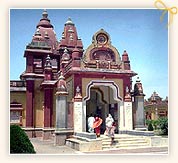 Dwarka
Dwarka, located in the state of Gujarat,
is revered as one of the
Chardhams (the four most scared
pilgrimage centers) of India and is associated with Lord Krishna's
life. Renowned in myth and legend, the city of Dwarka was once the
capital of Lord Krishna's empire and it is believed that he had
settled there after leaving Mathura, thousands of years ago.
According to the epic Mahabharata, when the Lord finally abandoned
his body, the holy city was submerged by the sea. The entire city
was revealed by marine excavations and like its ancient
counterpart, today Dwarka stands poised on the edge of the Kutchh
peninsula, facing the Arabian sea and the gateway to western
India.
The majestic
Dwarkadhish Temple (Jagat Mandir) at Dwarka is
one of the most imposing structures of Hindu architecture on the
confluence of river
Gomti and the Arabian Sea. This is a
five-storey high temple, built on seventy-two pillars. It is said
that
Vajranabha (Lord Krishna's grandson) built the
original temple of Dwarkadhish over the
Hari-griha (Lord
Krishna's residential palace). There are two entrances to the
Dwarkadhish temple - the north entrance (main entrance) is called
"Moksha Dwara" (Door to Salvation) and the south entrance
is called
"Swarga Dwara" (Gate to Heaven).
Dwarka is also famous for The
Sharada Peetha-one of the
four Mathas established by
Jagatguru AdiShankaracharya. The
Peetha has an educational society, an arts college and a Sanskrit
Academy, which prepares scholars for doctorates in Sanskrit and
Indology.
Mahakaleshwar
Ujjain in the
state of Madhya Pradesh is known for the famous Mahakaleswar
Temple which is among the 12 celebrated Jyotirlingas in
India. The Mahakaleshwar temple is located near a lake and has
five levels, one of which is underground. Brass lamps light the
way to the underground sanctum of the temple. The glory of this
temple has been vividly described in various puranas. The
lingam at the Mahakal is believed to be "Swayambhu"
(born of itself), deriving "Shakti" (power) from within itself as
against the other lingams which are ritually established and
invested with mantra-shakti. The idol of Mahakaleshwar is known to
be Dakshinamurti (facing the South). The idols of Ganesha,
Parvati and Kartikeya are installed in the west, north and east of
the sanctum sanctorum. The idol of Nagchandreshwar is open
for darshan only on the day of Nagpanchami. On Mahashivaratri,
there takes place a huge fair near the temple, and worship goes on
throughout the night. The Mahakal dominates the life of the people
and the city so much that even in the midst of the busy routine of
everyday preoccupations, it provides an unbreakable link with past
traditions.
Pandharpur
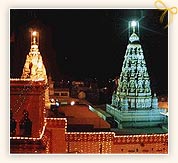
A small town called
Pandharpur in the
district of Solapur in Maharashtra is one of the most respected
Vitthala (Krishna) pilgrimage sites of the country. Pandharpur
is the abode of the famous
Lord Vitthala also known as
Panduranga, Pandhari or
Vithoba enshrined in the
Vithoba temple. This temple is the greatest center of attraction
in Pandharpur for the masses as far as the spiritual field goes.
This temple has a total of six gates and covers a large area.
Pandharpur hosts four "Yatras" in a year. The
"Aashadhi Yatra"
is the one which attracts most pilgrims (around 0.5 to 0.7
million) to Pandharpur every year. Devotees take holy bath in
river
Bhima and usually stand in long queues in order to
take
"Darshana" of Lord Vitthala. The second important
yatra is
"Kartiki". The huge crowds that accompany the
palanquins of the various saints to Pandharpur gives a clear image
of the popularity of
Vithoba in the region.
Shirdi
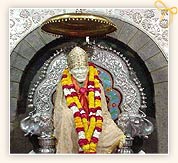
A small town in the Ahmednagar district of
Maharashtra,
Shirdi is an important place for every
religion. It is said that
Sri Sai Baba, a personification
of spiritual perfection and an epitome of compassion, lived in
Shirdi for 60 years. Pilgrims belonging to all faiths throng to
this holy place all the year around. There are many religious
spots in and around Shirdi, all dedicated to Sai Baba. The
Shirdi Saibaba Temple attracts millions of devotees of all
religions, castes and creed who come to pay homage to
Shri Sai
Baba. The famous
Samadhi Mandir is a beautiful shrine
that was built over the Samadhi of Shri Sai Baba. Just behind the
Samadhi is Sai Baba's statue made of Italian marble which shows
him seated on a throne.
Dwarkamai is situated on the right
side of the entrance of Samadhi Mandir and it is said that Baba
stayed at Dwarkamai till the very end of his life and it was here
he solved problems of the people, cured their sickness and
worries.
Gurusthan is the name given to the place where Sai
Baba was first spotted seated under a Neem tree which was later
converted to a temple. At a short distance from there lies Baba's
Chavadi where he used to sleep every alternate day. At some
distance from Gurustahan there is a
Lendi Baug (garden)
which is said to have been planted by Sai Baba and watered daily
by Baba himself.
Triambakeshwar
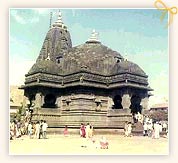 Tryambakeshwar
Tryambakeshwar is revered as one of the
12 Jyotirlinga shrines of Shiva, located at a distance of
about 30 kms from Nasik, Maharashtra. It is said that
Tryambakeshwar is the source of the river
Godavari. It
is also known by other names like
Trimbak or
Trimbakeshwar or Triambakeshwar or
Triyambakeshwar.
The
Tryambakeshwar Temple is an ancient Hindu temple
dedicated to Lord Shiva. The extraordinary feature of the
Jyotirlinga located here is that it has three faces embodying
the images of
Lord Brahma, Lord Vishnu and
Lord Shiva.
The entire black stone temple is known for its appealing
architecture and sculpture. This place is also famous for lots of
religious
"vidhis" (rituals) like
Narayan-Nagbali,
Kalsarpa Shanti, Tripindi vidhi etc.
Narayan-Nagbalipuja
is performed at this temple only. It is a sacred puja to fulfill
all your desires and is performed in three days. Trimabakeshwar
also has good number of Brahmin houses and is also a center for
Vedic Gurukuls. It also has
Ashrams and
Muths
devoted to
"Ashtanga Yoga" (the Hindu art of Living). The
place is well-known for its scenic beauty in rainy season and is
surrounded by unpolluted lush green hills.
Kanchipuram

Kanchipuram/Kanchi is located in the Indian state
of Tamil Nadu and considered to be one of the India's Seven Sacred
places. This place is the second holiest place after Varanasi. It
is a temple town dedicated to lord Shiva and originally was the
historical capital of the Pallavas. There are several magnificent
ancient temples of unique architectural beauty in Kanchi. The most
notable one is the
Ekambaranatha Temple which is one of the
five form of abodes of Lord Shiva.
Kamakshi Amman Temple,
Varadharaja Perumal Temple, Kumara Kottam, Kachapeshwarar Temple,
Kailasanathar Temple are other famous temples of the region of
Kanchi. Considered to be the "Golden city of Thousand Temples" and
the seat of Shankarcharya, Kanchipuram is visited by thousands of
devotees every year from all parts of the country. The teachings
of
AdiShankaracharya (spiritual teacher) are studied at and
propagated by the
Shankaracharya Muth and the headquarters
of the
"Muth" is situated at Kanchipuram.
Rameshwaram
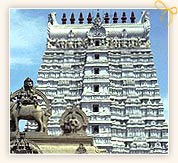
Rameswaram, situated about 164 kilometers
south-east of Madurai, Tamil Nadu is considered as one of the
"Chardhams"
(the four most scared pilgrimage centers) by the Hindus. It is an
important pilgrim center, famous for the Hindu temple dedicated to
Lord Rama and it is believed that Lord Rama descended on its
shores and built a bridge across the Palk Strait to reach Lanka in
his search to rescue
Sita from
Ravana.
The temple is also famous for being one of the
12 Jyotirlingas
of Lord Shiva, called the
Ramalingam which was built
Lord Rama to offer thanks to the Lord after killing
Ravana.
This holy city is an island paradise of golden sand. Devotees
consider Rameswaram as the Varanasi of the south and devotees
bathe in the sea. Rameswaram temple is known for its long
corridors and towers and 36
Theerthams. Rameswaram is one
of the most sacred towns of India, well known for its
temple
corridor - the longest in India, the
Bathing Ghat,
Ganthamathana Parvatham, Kothandaramar temple, Kurusadai and
other nearby temples.
Tirupati
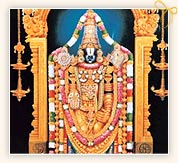
Located in the foot hills of Tirumala, Tirupati
is a famous temple town in Chittoor District of Andhra Pradesh. It
is the richest shrine in the Hindu world and the second busiest
and richest religious centre in the world after the Vatican. Every
year more than 12 million people visit this temple both from India
and abroad.
Tirupati Temple is the abode of
Lord
Venkateshwara (one of the incarnations of Lord Vishnu).
Tirumala has seven hills which represents the seven heads of a
huge serpent, called Sesha Saye, on which Lord Vishnu resides. The
black idol of Lord Vishnu or Balaji is covered in gold, jewellery
and precious ornaments and is 2 metres high. It is believed that
any wish expressed before this image of the Lord will always be
granted. Worship at the temple begins in early morning hours
before dawn, with
"Suprabhatham" when Lord Venkateswara is
woken from his rest. This morning ritual is an unforgettable
experience as the hundreds of oil lamps light up the sanctum and
the majesty of the image decked in glittering ornaments is seen.
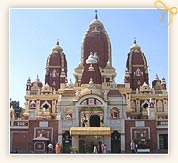 India is one of the most religiously diverse nations
in the world, with some of the most deeply religious societies and
cultures. The country has one of the oldest continuously operating
pilgrimage traditions in the world. The practice of pilgrimages is
deeply entrenched in the Indian psyche and the number of pilgrimage
sites are very large. Thus, the subcontinent may be considered as a
continuous sacred space.
India is one of the most religiously diverse nations
in the world, with some of the most deeply religious societies and
cultures. The country has one of the oldest continuously operating
pilgrimage traditions in the world. The practice of pilgrimages is
deeply entrenched in the Indian psyche and the number of pilgrimage
sites are very large. Thus, the subcontinent may be considered as a
continuous sacred space.
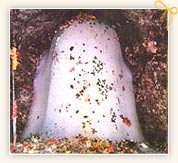 One of the holy shrines of the Hindus and located in
the state of Jammu and Kashmir is the Amarnath. The Amarnath
Cave is considered to be the abode of Lord Shiva and
Goddess Parvati. The Amarnath Yatra, for which one has
to trek at a height of about 14,500 ft from the sea level, starts from
the base village Bailganv (Pahalgam) and usually takes place in
the Hindu month of Shravan (July-August). In the seat of Lord
Amarnath, the image of Shiva, in the form of a lingam, gets formed of
ice every year. By its side are two more ice-lingams, considered to be
that of Parvati, and their son, Ganesha. The climatic conditions of
the region are very uncertain because rain or snowfall may take place
at any time during the Yatra. Even then there is no stopping the
thousands of devotees from flocking to this God's abode with full
thrill and joy. One will always feel his presence on this paradise of
the Earth, surrounded by beautiful valleys, mountains and snow.
One of the holy shrines of the Hindus and located in
the state of Jammu and Kashmir is the Amarnath. The Amarnath
Cave is considered to be the abode of Lord Shiva and
Goddess Parvati. The Amarnath Yatra, for which one has
to trek at a height of about 14,500 ft from the sea level, starts from
the base village Bailganv (Pahalgam) and usually takes place in
the Hindu month of Shravan (July-August). In the seat of Lord
Amarnath, the image of Shiva, in the form of a lingam, gets formed of
ice every year. By its side are two more ice-lingams, considered to be
that of Parvati, and their son, Ganesha. The climatic conditions of
the region are very uncertain because rain or snowfall may take place
at any time during the Yatra. Even then there is no stopping the
thousands of devotees from flocking to this God's abode with full
thrill and joy. One will always feel his presence on this paradise of
the Earth, surrounded by beautiful valleys, mountains and snow.
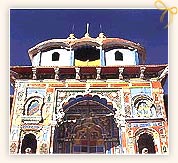 Badrinath is a Hindu holy town in Uttaranchal, India
and considered to be the most important of the four sites in India's
Chardham pilgrimage. It is an important destination on the sacred
itinerary of every devout Hindu. It has been emphasized in the ancient
scriptures that there are many sacred spots of pilgrimage in the
Earth, Heaven and the Nether world, but there has been none equal to
Badri nor there shall be. The significance of this place is that it is
considered to be the seat of the God Vishnu in his aspect of
Badrinarayana. The prime sites in this area are Badrinath Temple, Tapt
Kund, Brahma Kapal, Charanpaduka, Sheshnetra, Neelkantha. Another
important religious attraction at Badrinath is the Badrinath Temple
which is considered as the abode of Lord Vishnu and is situated at
3,124 meters above sea level in the Himalayas. The temple has three
parts - Garbha Grih (The Sanctum Sanctorum), Darshan Mandap (for pujas)
and Sabha Mandap (for devotees to assemble). At the backdrop is the
Neelkanth mountain peak situated between twin peaks named Nar and
Narayan. The Badrinath temple was built by the Gharwal kings.
Badrinath is a Hindu holy town in Uttaranchal, India
and considered to be the most important of the four sites in India's
Chardham pilgrimage. It is an important destination on the sacred
itinerary of every devout Hindu. It has been emphasized in the ancient
scriptures that there are many sacred spots of pilgrimage in the
Earth, Heaven and the Nether world, but there has been none equal to
Badri nor there shall be. The significance of this place is that it is
considered to be the seat of the God Vishnu in his aspect of
Badrinarayana. The prime sites in this area are Badrinath Temple, Tapt
Kund, Brahma Kapal, Charanpaduka, Sheshnetra, Neelkantha. Another
important religious attraction at Badrinath is the Badrinath Temple
which is considered as the abode of Lord Vishnu and is situated at
3,124 meters above sea level in the Himalayas. The temple has three
parts - Garbha Grih (The Sanctum Sanctorum), Darshan Mandap (for pujas)
and Sabha Mandap (for devotees to assemble). At the backdrop is the
Neelkanth mountain peak situated between twin peaks named Nar and
Narayan. The Badrinath temple was built by the Gharwal kings.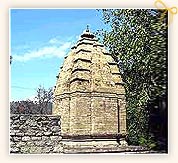 Chamunda Devi is revered as a Shakti shrine,
situated 10 km west of Palampur located in the state of Himachal
Pradesh. This is the place where the Demons Chand and Mund
came to conquer Devi Mahakali and during the fight, the Devi
cut their heads. The heads were then presented to Maa Ambika,
who in turn told Mahakali that She will be worshipped as Chamunda
Devi. This Sidhapeeth has now become a place where saints and
priests pray amidst natural surroundings. Since this colorful shrine
has a wrathful form of Chamunda or Mahakali, it is considered to be
very sacred. The idol in the temple is completely hidden beneath a red
cloth and it is believed that here Lord Shiva is present in the form
of death, destruction and dead bodies along with Chamunda Devi.
Devotees flock to this temple to offer prayers, worship and give
offerings for their ancestors.
Chamunda Devi is revered as a Shakti shrine,
situated 10 km west of Palampur located in the state of Himachal
Pradesh. This is the place where the Demons Chand and Mund
came to conquer Devi Mahakali and during the fight, the Devi
cut their heads. The heads were then presented to Maa Ambika,
who in turn told Mahakali that She will be worshipped as Chamunda
Devi. This Sidhapeeth has now become a place where saints and
priests pray amidst natural surroundings. Since this colorful shrine
has a wrathful form of Chamunda or Mahakali, it is considered to be
very sacred. The idol in the temple is completely hidden beneath a red
cloth and it is believed that here Lord Shiva is present in the form
of death, destruction and dead bodies along with Chamunda Devi.
Devotees flock to this temple to offer prayers, worship and give
offerings for their ancestors.
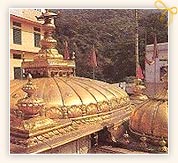 Chintpurni in the Una District of Himachal Pradesh
is famous for Mata Chintpurni Devi Temple. The Chintpurni
Temple besides having the idols of Mata Shri Chhinnamastika Devi
and Mata Shri Chintpurni Devi also has the idol of Chhina
Mastaka, the killer of the demon Nishumbha. This temple
is revered by the Hindus in Punjab, Haryana and Himachal Pradesh and
it is believed that the Goddess Chintpurni is the remover of
all troubles. The devotees bring with them their worldly concerns
and seek blessings from the Devi. It is said that if you ask
something from the Devi with a true heart, your wish will be
fulfilled. Devotees have been visiting this Shaktipeeth for hundreds
of years to pray at the lotus feet of both the Devis. Though the
temple is open all round the year, the best time to visit it is
during the 10-day fair held every year in the month of August.
Chintpurni in the Una District of Himachal Pradesh
is famous for Mata Chintpurni Devi Temple. The Chintpurni
Temple besides having the idols of Mata Shri Chhinnamastika Devi
and Mata Shri Chintpurni Devi also has the idol of Chhina
Mastaka, the killer of the demon Nishumbha. This temple
is revered by the Hindus in Punjab, Haryana and Himachal Pradesh and
it is believed that the Goddess Chintpurni is the remover of
all troubles. The devotees bring with them their worldly concerns
and seek blessings from the Devi. It is said that if you ask
something from the Devi with a true heart, your wish will be
fulfilled. Devotees have been visiting this Shaktipeeth for hundreds
of years to pray at the lotus feet of both the Devis. Though the
temple is open all round the year, the best time to visit it is
during the 10-day fair held every year in the month of August.
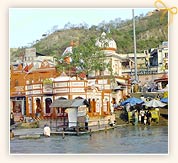 According to Hindus, Haridwar in Uttaranchal is one
of the holiest places in the country where it is believed that the
Devas have left their footprints on Earth. Literally meaning
Gateway to God, Haridwar represents the gateway to the
Himalayan pilgrimage shrines of Badrinath and Kedarnath
and it is the the point where the Ganga reaches the plains. The main
ghat at Haridwar is known as Hari-ki-Pauri which is renowned for a
footprint of Vishnu on a stone in a wall. There are five sacred
bathing spots in Haridwar known as Gangadwara, Kankhal, Nila
Parvata, Bilwa Theertha and Kusavarta. The Ganga aarti
which takes place every evening is a spectacular sight. The aarti
ceremony is performed at all temples in Haridwar at the same time.
There is the Gangadwara temple nearby which is considered to
be the most important of the several temples that are within this
town. Haridwar is also known by other names as Gangadwar, Mokshadwar,
Tapovan and Mayapuri while its ancient name was Kapilasthan.
The Kumbh Mela and the Ardh Kumbh Mela also take place
in this ancient town every 12 th and 6th year, respectively. Near
Haridwar are the towns of Mayapuri and Kankhal and Kankhal is famous
for the famous Daksheswara temple.
According to Hindus, Haridwar in Uttaranchal is one
of the holiest places in the country where it is believed that the
Devas have left their footprints on Earth. Literally meaning
Gateway to God, Haridwar represents the gateway to the
Himalayan pilgrimage shrines of Badrinath and Kedarnath
and it is the the point where the Ganga reaches the plains. The main
ghat at Haridwar is known as Hari-ki-Pauri which is renowned for a
footprint of Vishnu on a stone in a wall. There are five sacred
bathing spots in Haridwar known as Gangadwara, Kankhal, Nila
Parvata, Bilwa Theertha and Kusavarta. The Ganga aarti
which takes place every evening is a spectacular sight. The aarti
ceremony is performed at all temples in Haridwar at the same time.
There is the Gangadwara temple nearby which is considered to
be the most important of the several temples that are within this
town. Haridwar is also known by other names as Gangadwar, Mokshadwar,
Tapovan and Mayapuri while its ancient name was Kapilasthan.
The Kumbh Mela and the Ardh Kumbh Mela also take place
in this ancient town every 12 th and 6th year, respectively. Near
Haridwar are the towns of Mayapuri and Kankhal and Kankhal is famous
for the famous Daksheswara temple.
 Jwalaji in the Kangra district of Himachal Pradesh
is well-known for the famous Jwalaji Temple which is one of
the fifty-one Shakti Peeths in the country. It is said that when,
Sati, the consort of Lord Shiva, killed herself by jumping in the
sacrificial fire when her father Daksha Prajapati insulted her
husband, an enraged Shiva started roaming the entire universe with
the body of Sati in his arms. His movement created havoc and
imbalance in the Universe. To calm down the anger of Shiva, Lord
Vishnu dismembered the dead body of Sati and various parts of the
body fell at 51 different places in India which later on became
sacred as Shakti Peeths. It is believed that Sati's tongue
had fallen at the very place where Jwalaji Temple is now situated.
The tongue of Sati is represented by Jwala (Holy Flame) that
is perpetually burning. The flames come out from nine different
rocks in the temple. It is said that the Pandavas have visited this
sacred place. Even Emperor Akbar paid yearly visit to this Temple
after he became impressed with the holy flames that kept burning
even after he had put a massive chhatra (canopy) over it to
extinguish the flame. The climat of this region is quite moderate
with cool but pleasant winters and warm summers.
Jwalaji in the Kangra district of Himachal Pradesh
is well-known for the famous Jwalaji Temple which is one of
the fifty-one Shakti Peeths in the country. It is said that when,
Sati, the consort of Lord Shiva, killed herself by jumping in the
sacrificial fire when her father Daksha Prajapati insulted her
husband, an enraged Shiva started roaming the entire universe with
the body of Sati in his arms. His movement created havoc and
imbalance in the Universe. To calm down the anger of Shiva, Lord
Vishnu dismembered the dead body of Sati and various parts of the
body fell at 51 different places in India which later on became
sacred as Shakti Peeths. It is believed that Sati's tongue
had fallen at the very place where Jwalaji Temple is now situated.
The tongue of Sati is represented by Jwala (Holy Flame) that
is perpetually burning. The flames come out from nine different
rocks in the temple. It is said that the Pandavas have visited this
sacred place. Even Emperor Akbar paid yearly visit to this Temple
after he became impressed with the holy flames that kept burning
even after he had put a massive chhatra (canopy) over it to
extinguish the flame. The climat of this region is quite moderate
with cool but pleasant winters and warm summers.
 Kedarnath is a Hindu holy town located in the the
Indian state of Uttaranchal. The place is located at an altitude
of 3,584 m and at the origin of the river Mandakini, the temple of
Kedarnath is the most venerated place for Hindu pilgrims. Amidst
the dramatic mountain scapes of the majestic Kedarnath range
stands one of the twelve 'Jyotirlingas' of Kedar or Lord Shiva.
Kedarnath hosts one of the holiest Hindu temples and is a popular
destination for Hindu pilgrims from all over the world. The place
is accessible after a steep 13 km trek over a paved path from
Gaurikund. Rishikesh, Haridwar, Dehradun are well connected to
Gaurikund by road. There are different places on the route like-
Rambara, Janglechatti and Garurchatti, where one can spend some
time while trekking or can even spend a night as a halting
station. There is a high and beautiful cascading waterfall just
one kilometer before Rambara. The main attraction at Kedarnath is
the Kedarnath Jyotirlinga Temple, which is one of the Panch
Kendras located in the Himalayas, at the source of the Mandakani
river. It is about 120000 feet above the sea level. One can get a
glimpse of the God when traveling by foot. The picture perfect
setting with breathtaking scenic beauty transforms it in a heaven.
Perpetually covered with snow, the place is best accessible from
May to October except the Monsoon.
Kedarnath is a Hindu holy town located in the the
Indian state of Uttaranchal. The place is located at an altitude
of 3,584 m and at the origin of the river Mandakini, the temple of
Kedarnath is the most venerated place for Hindu pilgrims. Amidst
the dramatic mountain scapes of the majestic Kedarnath range
stands one of the twelve 'Jyotirlingas' of Kedar or Lord Shiva.
Kedarnath hosts one of the holiest Hindu temples and is a popular
destination for Hindu pilgrims from all over the world. The place
is accessible after a steep 13 km trek over a paved path from
Gaurikund. Rishikesh, Haridwar, Dehradun are well connected to
Gaurikund by road. There are different places on the route like-
Rambara, Janglechatti and Garurchatti, where one can spend some
time while trekking or can even spend a night as a halting
station. There is a high and beautiful cascading waterfall just
one kilometer before Rambara. The main attraction at Kedarnath is
the Kedarnath Jyotirlinga Temple, which is one of the Panch
Kendras located in the Himalayas, at the source of the Mandakani
river. It is about 120000 feet above the sea level. One can get a
glimpse of the God when traveling by foot. The picture perfect
setting with breathtaking scenic beauty transforms it in a heaven.
Perpetually covered with snow, the place is best accessible from
May to October except the Monsoon. Considered to be the birth place of Lord Krishna,
Mathura, a small town on the River Yamuna in the state of
Uttar Pradesh, is an important place of pilgrimage in the country.
Krishna is supposed to be the best known, best loved and most
complex of Lord Vishnu's manifestations. It is a place of temples
and shrines bustling with the thousands of devotees who come to
visit this place of Lord Krishna. There is the splendid temple at
the Katra Keshav Dev which marks the spot believed to be
Shri Krishna Janmasthan by his devotees. There is another
beautiful shrine, the Gita Mandir, on the Mathura-Vrindavan
Road which has a fine image of Shri Krishna in its sanctum. The
whole of the Bhagwad Gita is inscribed on the walls of this
temple. Another most popular shrine at Mathura is the
Dwarikadhish Temple to the north of the town. Vishram Ghat
is the most important of all the 25 ghats in Mathura today. It is
believed that Shri Krishna took his rest here after killing
Kansa. The aarti held at the Vishram Ghat is a
spectacular sight. It is also said that no pilgrimage to Mathura
is complete without a visit to its kunds. According to tradition,
there were 159 ancient kunds in all. Of these only four can be
seen. These are the Shiv Tal Kund, Potara Kund , Balbhadra Kund
and Saraswati Kund. The town has also a number of Shaivite
temples.
Considered to be the birth place of Lord Krishna,
Mathura, a small town on the River Yamuna in the state of
Uttar Pradesh, is an important place of pilgrimage in the country.
Krishna is supposed to be the best known, best loved and most
complex of Lord Vishnu's manifestations. It is a place of temples
and shrines bustling with the thousands of devotees who come to
visit this place of Lord Krishna. There is the splendid temple at
the Katra Keshav Dev which marks the spot believed to be
Shri Krishna Janmasthan by his devotees. There is another
beautiful shrine, the Gita Mandir, on the Mathura-Vrindavan
Road which has a fine image of Shri Krishna in its sanctum. The
whole of the Bhagwad Gita is inscribed on the walls of this
temple. Another most popular shrine at Mathura is the
Dwarikadhish Temple to the north of the town. Vishram Ghat
is the most important of all the 25 ghats in Mathura today. It is
believed that Shri Krishna took his rest here after killing
Kansa. The aarti held at the Vishram Ghat is a
spectacular sight. It is also said that no pilgrimage to Mathura
is complete without a visit to its kunds. According to tradition,
there were 159 ancient kunds in all. Of these only four can be
seen. These are the Shiv Tal Kund, Potara Kund , Balbhadra Kund
and Saraswati Kund. The town has also a number of Shaivite
temples.
 Prayag is situated at the confluence of holy
rivers Ganga and Yamuna in Allahabad, Uttar Pradesh and Indian
mythology states that the invisible Saraswati river also joins
here. Hence, it is also called Sangam and is said to have
soul cleansing powers. Prayag is considered to be one of
the ancient pilgrimage centers of India and is revered in the
hymns of the Rig Veda. Tradition regards this region between the
Ganga and the Yamuna as the most fertile region on earth. Sangam
draws pilgrims from all over the world round the year but
especially at the time of the Maha Kumbh Mela. Millions of
devotees bathe ritually in the waters to break the eternal cycle
of reincarnation. The most famous temples of Prayag are the
Hanuman temple, Saraswati Ghat and Patalpuri Temple.
Prayag is situated at the confluence of holy
rivers Ganga and Yamuna in Allahabad, Uttar Pradesh and Indian
mythology states that the invisible Saraswati river also joins
here. Hence, it is also called Sangam and is said to have
soul cleansing powers. Prayag is considered to be one of
the ancient pilgrimage centers of India and is revered in the
hymns of the Rig Veda. Tradition regards this region between the
Ganga and the Yamuna as the most fertile region on earth. Sangam
draws pilgrims from all over the world round the year but
especially at the time of the Maha Kumbh Mela. Millions of
devotees bathe ritually in the waters to break the eternal cycle
of reincarnation. The most famous temples of Prayag are the
Hanuman temple, Saraswati Ghat and Patalpuri Temple.
 Located in the Tehri-Garhwal region of Uttar
Pradesh, Rishikesh represents the Gateway to the Himalayas. It is
small town, renowned as an important pilgrimage center of the
country. The town abounds in natural splendour and the sight of
the Ganga rushing through the Himalayan foothills is awesome.
There are several temples on the banks of the Ganga at Rishikesh.
It is believed that Rishikesh represents the site where Vishnu
vanquished the demon Madhu. In Tapovan, on the other
side of the Ganges, is a temple to Lakshmana. The Lakshman
Jhula at Rishikesh is a 450 feet long suspension bridge was
built in 1939. There is a newer bridge which has been added
recently - the Ram Jhula. Another commanding spectacular
view of the region is the Nilkanth Mahadeo temple at a
height of about 5000 feet, 12 km away from Rishikesh. Rishikesh is
not only popular for its religious significance but also
considered to be a base for devotees on their journey to the
Char Dham Yatra (tour of four pilgrim sites). The freshness of
the air, sound of flowing water, the scenic beauty, the distant
sound of bells create an unforgettable experience for those that
visit this ancient town.
Located in the Tehri-Garhwal region of Uttar
Pradesh, Rishikesh represents the Gateway to the Himalayas. It is
small town, renowned as an important pilgrimage center of the
country. The town abounds in natural splendour and the sight of
the Ganga rushing through the Himalayan foothills is awesome.
There are several temples on the banks of the Ganga at Rishikesh.
It is believed that Rishikesh represents the site where Vishnu
vanquished the demon Madhu. In Tapovan, on the other
side of the Ganges, is a temple to Lakshmana. The Lakshman
Jhula at Rishikesh is a 450 feet long suspension bridge was
built in 1939. There is a newer bridge which has been added
recently - the Ram Jhula. Another commanding spectacular
view of the region is the Nilkanth Mahadeo temple at a
height of about 5000 feet, 12 km away from Rishikesh. Rishikesh is
not only popular for its religious significance but also
considered to be a base for devotees on their journey to the
Char Dham Yatra (tour of four pilgrim sites). The freshness of
the air, sound of flowing water, the scenic beauty, the distant
sound of bells create an unforgettable experience for those that
visit this ancient town.
 Uttarkashi is an important pilgrimage center of
the country located in the Garhwal region of the state of
Uttaranchal. Situated at a distance of 145 kms from Rishikesh and
at an elevation of 1158 meters on the banks of river Bhagirathi,
this ancient town is the gateway to the pilgrim route to
Gangotri and Yamunotri. Uttarkashi also holds the grace
of having the origin of rivers Ganga and Yamuna. It is also known
as the "Devbhumi" (The land of gods and goddesses).
Uttarkashi is known for its temples dedicated to Parshurama,
Annapurna, Devi, Datatryea, Kali Bhairon and other gods and
goddesses. The climate of Uttarkashi is cold in winters and
pleasant in summers. Not only the place an important religious
center but also with its charming valleys, natural lakes,
fountains and beauteous landscapes, ridges and mountains with
snow-capped peaks makes the district an utmost attraction for the
tourists, the pilgrims and for those having a zeal for adventures
of trekking and mountaineering.
Uttarkashi is an important pilgrimage center of
the country located in the Garhwal region of the state of
Uttaranchal. Situated at a distance of 145 kms from Rishikesh and
at an elevation of 1158 meters on the banks of river Bhagirathi,
this ancient town is the gateway to the pilgrim route to
Gangotri and Yamunotri. Uttarkashi also holds the grace
of having the origin of rivers Ganga and Yamuna. It is also known
as the "Devbhumi" (The land of gods and goddesses).
Uttarkashi is known for its temples dedicated to Parshurama,
Annapurna, Devi, Datatryea, Kali Bhairon and other gods and
goddesses. The climate of Uttarkashi is cold in winters and
pleasant in summers. Not only the place an important religious
center but also with its charming valleys, natural lakes,
fountains and beauteous landscapes, ridges and mountains with
snow-capped peaks makes the district an utmost attraction for the
tourists, the pilgrims and for those having a zeal for adventures
of trekking and mountaineering.
 Vaishno Devi is one of the most important
pilgrimage centers of the country. It is located in the mighty
Trikuta mountain, 61 kilometers north of Jammu at a height of
5,200 feet above the sea level in the state of Jammu and Kashmir.
According to legend, more than 700 years ago Vaishno Devi a
devotee of Lord Vishnu had taken vow of celibacy but Bhairon Nath,
a "tantric" (demon-God) tried to behold Her and chased her
towards the Trikuta mountains. It took Bhairon nine months to
locate Her inside the cave known as Garbh Joon. Mata
Vaishno Devi blasted an opening at the other end of the cave and
on arriving at the Holy Cave at Darbar, she assumed the form of
Maha Kali and thereby cut off Bhairon Nath's head. The head
then flung up the mountain by the force of the blow and fell at
the place where now the Bhairon Temple is located. It is a
common belief among the devotees that Maa Vaishno sends a
"call' to her devotees and whoever receives it, wherever he or
she is, marches towards the holy shrine. It seems there is a
supernatural power which seems to draw them through the mountain
and they climb up those great heights, chanting "Prem se bolo,
Jai Mata Di". There are images of three deities inside the
cave-The Mahakali, Maa Saraswati and Maha Lakshmi. The
shrine of Vaishno Devi is flocked every year by thousands of
pilgrims.
Vaishno Devi is one of the most important
pilgrimage centers of the country. It is located in the mighty
Trikuta mountain, 61 kilometers north of Jammu at a height of
5,200 feet above the sea level in the state of Jammu and Kashmir.
According to legend, more than 700 years ago Vaishno Devi a
devotee of Lord Vishnu had taken vow of celibacy but Bhairon Nath,
a "tantric" (demon-God) tried to behold Her and chased her
towards the Trikuta mountains. It took Bhairon nine months to
locate Her inside the cave known as Garbh Joon. Mata
Vaishno Devi blasted an opening at the other end of the cave and
on arriving at the Holy Cave at Darbar, she assumed the form of
Maha Kali and thereby cut off Bhairon Nath's head. The head
then flung up the mountain by the force of the blow and fell at
the place where now the Bhairon Temple is located. It is a
common belief among the devotees that Maa Vaishno sends a
"call' to her devotees and whoever receives it, wherever he or
she is, marches towards the holy shrine. It seems there is a
supernatural power which seems to draw them through the mountain
and they climb up those great heights, chanting "Prem se bolo,
Jai Mata Di". There are images of three deities inside the
cave-The Mahakali, Maa Saraswati and Maha Lakshmi. The
shrine of Vaishno Devi is flocked every year by thousands of
pilgrims.
 Varanasi also known as Benares, Banaras, or
Benaras or Kashi is a renowned Hindu holy city situated on the
banks of the river Ganges in the state of Uttar Pradesh. According
to legends, the city was founded by Hindu god Shiva, and
hence it is one of the most important pilgrimage destinations in
the country. In fact, it is considered to be one of the seven
sacred cities of Hindus where more than 1,000,000 pilgrims visit
each year. There are large number of temples in the city. The most
important one is the Kashi Vishwanath Temple (an aspect of
Lord Shiva) which is one of the 12 revered Jyotirlingas of
the Lord Shiva. There is also the red coloured Durga Temple
accompanied by a rectangular tank of water called Durga Kund.
There is the Birla Temple built as a replica of the old
Kashi Vishwanath Temple. According to a popular belief, this city
is one of the Shakti Peeths where Divine Mother Sati's
earring fell and therein stands the present Vishalakshi Temple.
Some says that it is one of the four pilgrimage sites designated
by Gautama Buddha. It is also a pilgrimage place for Jains
as it is said to be the birthplace of Parshvanatha, the
23rd Tirthankar. Vaishnavism and Shaivism have co-existed in this
holy place harmoniously. This place is so sacred that there is a
belief that people dying in the holy city of Varanasi circumvents
rebirth and attains salvation.
Varanasi also known as Benares, Banaras, or
Benaras or Kashi is a renowned Hindu holy city situated on the
banks of the river Ganges in the state of Uttar Pradesh. According
to legends, the city was founded by Hindu god Shiva, and
hence it is one of the most important pilgrimage destinations in
the country. In fact, it is considered to be one of the seven
sacred cities of Hindus where more than 1,000,000 pilgrims visit
each year. There are large number of temples in the city. The most
important one is the Kashi Vishwanath Temple (an aspect of
Lord Shiva) which is one of the 12 revered Jyotirlingas of
the Lord Shiva. There is also the red coloured Durga Temple
accompanied by a rectangular tank of water called Durga Kund.
There is the Birla Temple built as a replica of the old
Kashi Vishwanath Temple. According to a popular belief, this city
is one of the Shakti Peeths where Divine Mother Sati's
earring fell and therein stands the present Vishalakshi Temple.
Some says that it is one of the four pilgrimage sites designated
by Gautama Buddha. It is also a pilgrimage place for Jains
as it is said to be the birthplace of Parshvanatha, the
23rd Tirthankar. Vaishnavism and Shaivism have co-existed in this
holy place harmoniously. This place is so sacred that there is a
belief that people dying in the holy city of Varanasi circumvents
rebirth and attains salvation.
 Located at a distance of 15 km from Mathura in
the state of Uttar Pradesh, Vrindavan is another major place of
pilgrimage among the Hindus. Also known as Vrindaban, Brindavan,
or Brindavana, or Brindaban, this holy place is the site of
the original forest or forested region, in which Lord Krishna
spent his childhood. It is believed that Lord Krishna was raised
there in the cow-herding village of Gokula by His foster
parents. Vrindavan is today famous for its numerous temples-both
old and new. Some of the notable ones are The Madan Mohan
Temple located near the Kali Ghat, the oldest existent temple
in Vrindavan today. The Banke-Bihari Temple is another
popular shrine at Vrindavan. The famous Radha Vallabh Temple
has the crown of Radha-Rani placed next to the Shri Krishna idol
in the sanctum. The Jaipur Temple is a richly embellished
and opulent temple. There is also the Shahji Temple where
the idols at the temple are popularly known as the Chhote Radha
Raman. Considered to be the abode of Lord Krishna, it is one
of India's most holiest cities with more than 5000 temples
dedicated to Lord Krishna.
Located at a distance of 15 km from Mathura in
the state of Uttar Pradesh, Vrindavan is another major place of
pilgrimage among the Hindus. Also known as Vrindaban, Brindavan,
or Brindavana, or Brindaban, this holy place is the site of
the original forest or forested region, in which Lord Krishna
spent his childhood. It is believed that Lord Krishna was raised
there in the cow-herding village of Gokula by His foster
parents. Vrindavan is today famous for its numerous temples-both
old and new. Some of the notable ones are The Madan Mohan
Temple located near the Kali Ghat, the oldest existent temple
in Vrindavan today. The Banke-Bihari Temple is another
popular shrine at Vrindavan. The famous Radha Vallabh Temple
has the crown of Radha-Rani placed next to the Shri Krishna idol
in the sanctum. The Jaipur Temple is a richly embellished
and opulent temple. There is also the Shahji Temple where
the idols at the temple are popularly known as the Chhote Radha
Raman. Considered to be the abode of Lord Krishna, it is one
of India's most holiest cities with more than 5000 temples
dedicated to Lord Krishna.
 Dwarka, located in the state of Gujarat,
is revered as one of the Chardhams (the four most scared
pilgrimage centers) of India and is associated with Lord Krishna's
life. Renowned in myth and legend, the city of Dwarka was once the
capital of Lord Krishna's empire and it is believed that he had
settled there after leaving Mathura, thousands of years ago.
According to the epic Mahabharata, when the Lord finally abandoned
his body, the holy city was submerged by the sea. The entire city
was revealed by marine excavations and like its ancient
counterpart, today Dwarka stands poised on the edge of the Kutchh
peninsula, facing the Arabian sea and the gateway to western
India.
Dwarka, located in the state of Gujarat,
is revered as one of the Chardhams (the four most scared
pilgrimage centers) of India and is associated with Lord Krishna's
life. Renowned in myth and legend, the city of Dwarka was once the
capital of Lord Krishna's empire and it is believed that he had
settled there after leaving Mathura, thousands of years ago.
According to the epic Mahabharata, when the Lord finally abandoned
his body, the holy city was submerged by the sea. The entire city
was revealed by marine excavations and like its ancient
counterpart, today Dwarka stands poised on the edge of the Kutchh
peninsula, facing the Arabian sea and the gateway to western
India. A small town called Pandharpur in the
district of Solapur in Maharashtra is one of the most respected
Vitthala (Krishna) pilgrimage sites of the country. Pandharpur
is the abode of the famous Lord Vitthala also known as
Panduranga, Pandhari or Vithoba enshrined in the
Vithoba temple. This temple is the greatest center of attraction
in Pandharpur for the masses as far as the spiritual field goes.
This temple has a total of six gates and covers a large area.
A small town called Pandharpur in the
district of Solapur in Maharashtra is one of the most respected
Vitthala (Krishna) pilgrimage sites of the country. Pandharpur
is the abode of the famous Lord Vitthala also known as
Panduranga, Pandhari or Vithoba enshrined in the
Vithoba temple. This temple is the greatest center of attraction
in Pandharpur for the masses as far as the spiritual field goes.
This temple has a total of six gates and covers a large area. A small town in the Ahmednagar district of
Maharashtra, Shirdi is an important place for every
religion. It is said that Sri Sai Baba, a personification
of spiritual perfection and an epitome of compassion, lived in
Shirdi for 60 years. Pilgrims belonging to all faiths throng to
this holy place all the year around. There are many religious
spots in and around Shirdi, all dedicated to Sai Baba. The
Shirdi Saibaba Temple attracts millions of devotees of all
religions, castes and creed who come to pay homage to Shri Sai
Baba. The famous Samadhi Mandir is a beautiful shrine
that was built over the Samadhi of Shri Sai Baba. Just behind the
Samadhi is Sai Baba's statue made of Italian marble which shows
him seated on a throne. Dwarkamai is situated on the right
side of the entrance of Samadhi Mandir and it is said that Baba
stayed at Dwarkamai till the very end of his life and it was here
he solved problems of the people, cured their sickness and
worries. Gurusthan is the name given to the place where Sai
Baba was first spotted seated under a Neem tree which was later
converted to a temple. At a short distance from there lies Baba's
Chavadi where he used to sleep every alternate day. At some
distance from Gurustahan there is a Lendi Baug (garden)
which is said to have been planted by Sai Baba and watered daily
by Baba himself.
A small town in the Ahmednagar district of
Maharashtra, Shirdi is an important place for every
religion. It is said that Sri Sai Baba, a personification
of spiritual perfection and an epitome of compassion, lived in
Shirdi for 60 years. Pilgrims belonging to all faiths throng to
this holy place all the year around. There are many religious
spots in and around Shirdi, all dedicated to Sai Baba. The
Shirdi Saibaba Temple attracts millions of devotees of all
religions, castes and creed who come to pay homage to Shri Sai
Baba. The famous Samadhi Mandir is a beautiful shrine
that was built over the Samadhi of Shri Sai Baba. Just behind the
Samadhi is Sai Baba's statue made of Italian marble which shows
him seated on a throne. Dwarkamai is situated on the right
side of the entrance of Samadhi Mandir and it is said that Baba
stayed at Dwarkamai till the very end of his life and it was here
he solved problems of the people, cured their sickness and
worries. Gurusthan is the name given to the place where Sai
Baba was first spotted seated under a Neem tree which was later
converted to a temple. At a short distance from there lies Baba's
Chavadi where he used to sleep every alternate day. At some
distance from Gurustahan there is a Lendi Baug (garden)
which is said to have been planted by Sai Baba and watered daily
by Baba himself.
 Tryambakeshwar is revered as one of the
12 Jyotirlinga shrines of Shiva, located at a distance of
about 30 kms from Nasik, Maharashtra. It is said that
Tryambakeshwar is the source of the river Godavari. It
is also known by other names like Trimbak or
Trimbakeshwar or Triambakeshwar or Triyambakeshwar.
Tryambakeshwar is revered as one of the
12 Jyotirlinga shrines of Shiva, located at a distance of
about 30 kms from Nasik, Maharashtra. It is said that
Tryambakeshwar is the source of the river Godavari. It
is also known by other names like Trimbak or
Trimbakeshwar or Triambakeshwar or Triyambakeshwar. Kanchipuram/Kanchi is located in the Indian state
of Tamil Nadu and considered to be one of the India's Seven Sacred
places. This place is the second holiest place after Varanasi. It
is a temple town dedicated to lord Shiva and originally was the
historical capital of the Pallavas. There are several magnificent
ancient temples of unique architectural beauty in Kanchi. The most
notable one is the Ekambaranatha Temple which is one of the
five form of abodes of Lord Shiva. Kamakshi Amman Temple,
Varadharaja Perumal Temple, Kumara Kottam, Kachapeshwarar Temple,
Kailasanathar Temple are other famous temples of the region of
Kanchi. Considered to be the "Golden city of Thousand Temples" and
the seat of Shankarcharya, Kanchipuram is visited by thousands of
devotees every year from all parts of the country. The teachings
of AdiShankaracharya (spiritual teacher) are studied at and
propagated by the Shankaracharya Muth and the headquarters
of the "Muth" is situated at Kanchipuram.
Kanchipuram/Kanchi is located in the Indian state
of Tamil Nadu and considered to be one of the India's Seven Sacred
places. This place is the second holiest place after Varanasi. It
is a temple town dedicated to lord Shiva and originally was the
historical capital of the Pallavas. There are several magnificent
ancient temples of unique architectural beauty in Kanchi. The most
notable one is the Ekambaranatha Temple which is one of the
five form of abodes of Lord Shiva. Kamakshi Amman Temple,
Varadharaja Perumal Temple, Kumara Kottam, Kachapeshwarar Temple,
Kailasanathar Temple are other famous temples of the region of
Kanchi. Considered to be the "Golden city of Thousand Temples" and
the seat of Shankarcharya, Kanchipuram is visited by thousands of
devotees every year from all parts of the country. The teachings
of AdiShankaracharya (spiritual teacher) are studied at and
propagated by the Shankaracharya Muth and the headquarters
of the "Muth" is situated at Kanchipuram.
 Rameswaram, situated about 164 kilometers
south-east of Madurai, Tamil Nadu is considered as one of the "Chardhams"
(the four most scared pilgrimage centers) by the Hindus. It is an
important pilgrim center, famous for the Hindu temple dedicated to
Lord Rama and it is believed that Lord Rama descended on its
shores and built a bridge across the Palk Strait to reach Lanka in
his search to rescue Sita from Ravana.
Rameswaram, situated about 164 kilometers
south-east of Madurai, Tamil Nadu is considered as one of the "Chardhams"
(the four most scared pilgrimage centers) by the Hindus. It is an
important pilgrim center, famous for the Hindu temple dedicated to
Lord Rama and it is believed that Lord Rama descended on its
shores and built a bridge across the Palk Strait to reach Lanka in
his search to rescue Sita from Ravana. Located in the foot hills of Tirumala, Tirupati
is a famous temple town in Chittoor District of Andhra Pradesh. It
is the richest shrine in the Hindu world and the second busiest
and richest religious centre in the world after the Vatican. Every
year more than 12 million people visit this temple both from India
and abroad. Tirupati Temple is the abode of Lord
Venkateshwara (one of the incarnations of Lord Vishnu).
Tirumala has seven hills which represents the seven heads of a
huge serpent, called Sesha Saye, on which Lord Vishnu resides. The
black idol of Lord Vishnu or Balaji is covered in gold, jewellery
and precious ornaments and is 2 metres high. It is believed that
any wish expressed before this image of the Lord will always be
granted. Worship at the temple begins in early morning hours
before dawn, with "Suprabhatham" when Lord Venkateswara is
woken from his rest. This morning ritual is an unforgettable
experience as the hundreds of oil lamps light up the sanctum and
the majesty of the image decked in glittering ornaments is seen.
Located in the foot hills of Tirumala, Tirupati
is a famous temple town in Chittoor District of Andhra Pradesh. It
is the richest shrine in the Hindu world and the second busiest
and richest religious centre in the world after the Vatican. Every
year more than 12 million people visit this temple both from India
and abroad. Tirupati Temple is the abode of Lord
Venkateshwara (one of the incarnations of Lord Vishnu).
Tirumala has seven hills which represents the seven heads of a
huge serpent, called Sesha Saye, on which Lord Vishnu resides. The
black idol of Lord Vishnu or Balaji is covered in gold, jewellery
and precious ornaments and is 2 metres high. It is believed that
any wish expressed before this image of the Lord will always be
granted. Worship at the temple begins in early morning hours
before dawn, with "Suprabhatham" when Lord Venkateswara is
woken from his rest. This morning ritual is an unforgettable
experience as the hundreds of oil lamps light up the sanctum and
the majesty of the image decked in glittering ornaments is seen.